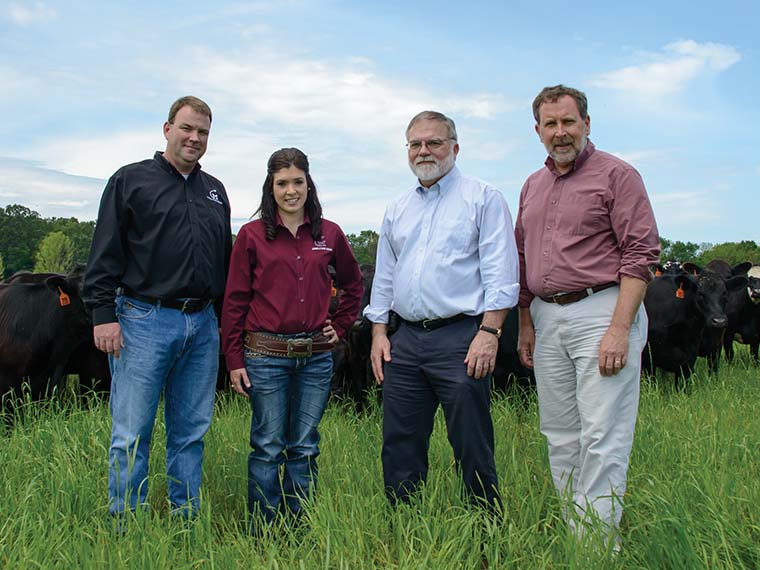The information presented on this page may be dated. It may refer to situations which have changed or people who are no longer affiliated with the university. It is archived as part of Mississippi State University's history.
The Mississippi State University College of Veterinary Medicine, or CVM, conducts world-class research in animal and public health, provides high-quality learning experiences, and cutting-edge medical care. CVM has three departments: Pathobiology and Population Medicine, Clinical Sciences, and Basic Sciences. The Department of Pathobiology and Population Medicine develops resources for professionals engaged in farm animal production, while the Department of Basic Sciences covers an array of scientific disciplines that can be applied to the study of animals. The Department of Clinical Sciences focuses on primary, secondary, and tertiary veterinary care. The College also houses a diagnostic laboratory system, the Center for Environmental Health Sciences, and offers clinical services and patient care. Students can obtain master and doctoral degrees in veterinary medicine and a doctoral degree in environmental toxicology.
While all CVM departments work closely with scientists in the Mississippi Agricultural and Forestry Experiment Station, this issue of MAFES Discovers highlights the work of Dr. David Smith, the Mikell and Mary Cheek Hall Davis Endowed Professor in the Department of Pathobiology and Population Medicine. His research focuses on beef cattle production. In his work, he hopes to stay ahead of the curve, solving relevant, real-world problems that have a direct effect on food safety for consumers; that improve the health and well-being of cattle, and advance the economic well-being of veterinarians and cattle producers alike. He also works to help students learn and grow as researchers and practitioners.
Currently, he is collaborating with Dr. Brandi Karisch, MAFES scientists and assistant research and extension professor in the Department of Animal and Dairy Sciences in the College of Agriculture and Life Sciences. Other researchers involved include Dr. Amelia Woolums and Dr. Robert Wills, both professors in the Department of Pathobiology and Population Medicine in the College of Veterinary Medicine; Dr. John Blanton, professor and head of the Department of Animal and Dairy Sciences; and Dr. Bill Epperson, professor and head of the Department of Pathobiology and Population Medicine in the College of Veterinary Medicine. The researchers are studying how stocker cattle producers can improve the health of their cattle.
"The stocker cattle industry adds value to cattle from the Southeastern U.S. by creating uniformity in body weight, evening out cattle numbers, and improving the health of calves entering finishing feed yards. Currently, stocker cattle producers face tremendous challenges keeping lightweight high-risk cattle healthy after they arrive on their farms. This will become more critical as antibiotic use becomes increasingly restricted," Smith explained.
Through a series of studies, Smith and his colleagues have learned that calves entering the stocker phase are prone to respiratory disease and parasites. Currently, stocker operators vaccinate and deworm calves when they enter the stocker operation to protect against these issues. Smith's research is trying to determine if those processes are effective in protecting the health of the calves, and if not, how to improve the system. Researchers have determined vulnerability is highest in calves younger than six months, weighing approximately 300 pounds, which is when many of them are entering the stocker market.
"The calves have lost the antibodies they acquired from colostrum by about 90 days of age and they don't really develop a strong immune response until around six months of age. In our research, cows older than six months or those that weighed closer to 500 pounds were less prone to these illnesses compared to the younger 300-pound cows."
In a recent study, the researchers created a system that imitated a stocker operation and brought in auction-market origin calves. They vaccinated them against respiratory disease and dewormed them for parasites in a fashion typical for the industry.
"We learned from that study that we did more harm than good by vaccinating those calves at the time of arrival. The calves that received the vaccination on arrival were more likely to get sick and didn't perform as well. If the calf came in with a parasite load, they were also more likely to get sick but deworming in the first few days didn't help either," Smith said.
The research indicated the timing of administering the vaccine and deworming the calves might need to occur sooner. By the time the calves enter the stocker operation, it might already be too late.
While the scientists are still replicating these studies, Smith hopes the research may one day help inform producers on the cow/calf side and during the stocker phase.
"Our research might inform a system where cow/calf operators may be incentivized to vaccinate and deworm ahead of marketing them because stocker operators place a higher value on calves that have been castrated, dehorned, vaccinated and dewormed at an earlier stage," Smith said.

